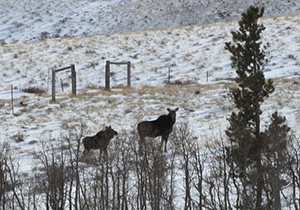
Contact Us
Institutional Communications
Bureau of Mines Building, Room 137
Laramie, WY 82071
Phone: (307) 766-2929
Email: cbaldwin@uwyo.edu
UWs Biodiversity Institute Helps Coordinate Winter Moose Day Feb. 15
Published January 28, 2020

A cow and calf pair are observed in the Woods Landing/Jelm area during the 2019 Winter
Moose Day. (iNaturalist Photo)
Strap on your snowshoes or skis, and grab a friend to enjoy Wyoming’s national forests while searching for moose.
For the sixth year, citizen scientists will be able to help track moose populations in the mountains outside of Laramie for Winter Moose Day. The event, coordinated in part by the University of Wyoming’s Biodiversity Institute, is scheduled Saturday, Feb. 15, in the Vedauwoo/Happy Jack and Snowy Range mountain areas. Preregistration is required by Saturday, Feb. 8.
The Wyoming Game and Fish Department, and the Wyoming Cooperative Fish and Wildlife Research Unit also coordinate the program and event.
Volunteers adopt survey routes and ski or snowshoe those routes to record all observations of moose or signs of moose. These can include tracks/hoofprints in snow, bed areas, scat droppings and signs of browsing on aspen and willows. The volunteer observations can be loaded into iNaturalist so the public can view where moose were seen. iNaturalist is a joint initiative of the California Academy of Sciences and the National Geographic Society.
“There were 26 moose or signs of moose that were uploaded to iNaturalist from the 2019 Winter Moose Day,” says Mason Lee, senior project coordinator of the Biodiversity Institute.
The data gathered from the Winter Moose Day is shared with biologists at the Wyoming Game and Fish Department and UW. Biologists use the data collected by citizen scientists to further their understanding of the population densities of local moose, reproductive rates, summer habitat quality, their winter ranges and how these variables change over time.
According to a 2018 Wyoming Game and Fish Department report, there is an estimated 3,460 moose in Wyoming. That number is down from a 2014 Game and Fish report Lee cited that estimated the state’s moose population was at 4,050.
“It’s a variety of issues,” says Sara DiRienzo, public information officer for the Wyoming Game and Fish Department office in Cheyenne. “The populations are really influenced by disease and some habitat changes.”
The carotid artery worm and winter ticks affect moose, especially in drier springs, she says. Moose can often become anemic when subjected to these parasites. Additionally, habitat loss or change can negatively affect moose populations, she says. A lot of shrub communities are old and overused, meaning there is less food available for moose in those areas. Wildfires also can have an adverse effect on moose by removing hard cover that gives moose shelter from the heat.
“The best conditions for moose are wet, cool shady areas,” DiRienzo says.
Predation from bears and wolves and, to a lesser extent, mountain lions, can affect moose numbers, she adds.
DiRienzo says hunting has very little impact on Wyoming moose populations, as licenses to hunt moose “are very limited” within the state.
Both the winter and summer Moose Day events are geared toward increasing the public’s understanding of moose in the Laramie area, and involving the public in asking and answering questions. These events are an extension of the original program, Moose Day, held by Nature Mapping Jackson Hole (NMJH) in Jackson each winter. NMJH is a citizen science program created by the Jackson Hole Wildlife Foundation.
For those interested in participating in Winter Moose Day, visit www.wyomingbiodiversity.org/moose-day and adopt a route by Saturday, Feb. 8.
Required training for new participants is scheduled Monday, Feb. 10, at 7 p.m. in the Berry Biodiversity Conservation Center. To survey while moose are most active, participants are asked to get to their routes as early as dawn and to complete their surveys by noon Feb. 15.
The UW Biodiversity Institute fosters conservation of biodiversity through scientific discovery, creative dissemination, education and public engagement. In this setting, scientists and citizens, students and educators come together to share a wealth of perspectives on the study and appreciation of biodiversity -- from microbes to poetry and ecosystems to economics. To learn more, visit www.wyomingbiodiversity.org.
Contact Us
Institutional Communications
Bureau of Mines Building, Room 137
Laramie, WY 82071
Phone: (307) 766-2929
Email: cbaldwin@uwyo.edu
